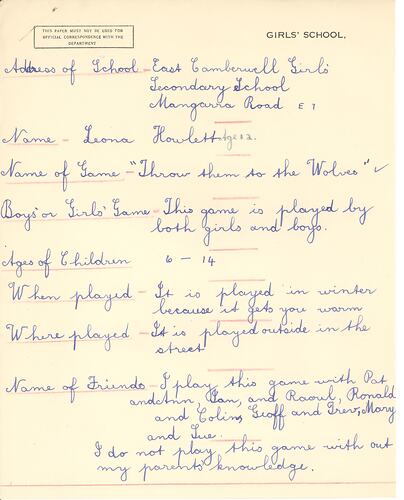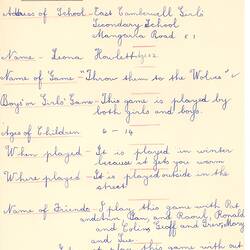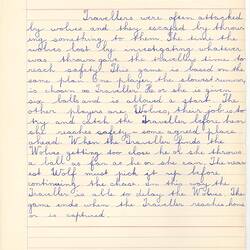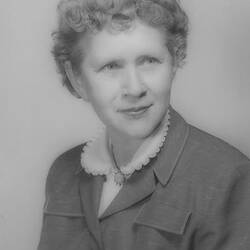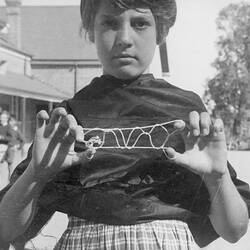Summary
Game name (and type): 'Throw them to the Wolves' (chasing game)
Alternative types: ball games
Handwritten description of the chasing game 'Throw them to the Wolves' composed for Dr Dorothy Howard by Leona Howlett, a twelve year old student at East Camberwell Girls Secondary School, in 1954-1955. Howlett describes 'Throw them to the Wolves' as a game requiring six balls and players aged between six and fourteen, which is played outside on a street during winter. She writes that the game is founded on the experiences of travellers, who have been attacked by wolves. To play, the slowest runner assumes the role of the 'traveller' and receives six balls to be used to divert the attention of the wolves. Howlett explains that the 'traveller' runs towards a predetermined safe location and is chased by the other players, who have become the wolves. If the 'traveller' throws a ball, the closest wolf must collect it before resuming the chase. Howlett states the game concludes when the 'traveller' reaches safety or is captured. Howlett lists other players of 'Throw them to the Wolves' including Pat, Ann, Jan, Raoul, Ronald, Colin, Geoff, Trev, Mary and Sue.
One of a collection of letters describing a children's game written to children's Folklorist Dorothy Howard between 1954 and 1955. Dr. Howard came to Australia in 1954-55 as an American Fulbright scholar to study Australian children's folklore. She travelled across Australia for 10 months collecting children's playground rhymes, games, play artefacts, etc. This letter, together with the other original fieldwork collected by Dr. Howard during this period, is preserved in the Dorothy Howard Collection manuscript files, part of the Australian Children's Folklore Collection (ACFC), Archive Series 3. The ACFC is an extensive collection documenting children's folklore and related research.
Physical Description
Handwritten game description in blue ink on paper. Comprises two sheets. First page features a letterhead printed in black ink and text underlined with red pencil; second page features a border ruled in red pencil.
More Information
-
Collection Names
Australian Children's Folklore Collection, Dorothy Howard Collection
-
Collecting Areas
-
Acquisition Information
Cultural Gifts Donation from Dr June Factor, 18 May 1999
-
Acknowledgement
Donated through the Australian Government's Cultural Gifts Program.
-
Author
Leona Howlett - East Camberwell Girls' Secondary School (College), Greater Melbourne, Victoria, Australia, 1954-1955
-
Addressed To
-
Collector
-
Organisation Named
East Camberwell Girls' Secondary School (College), East Camberwell, Greater Melbourne, Victoria, Australia
-
Classification
-
Category
-
Discipline
-
Type of item
-
Overall Dimensions
203 mm (Width), 254 mm (Height)
Orientation: portrait. Dimensions include first page only.
-
Keywords
